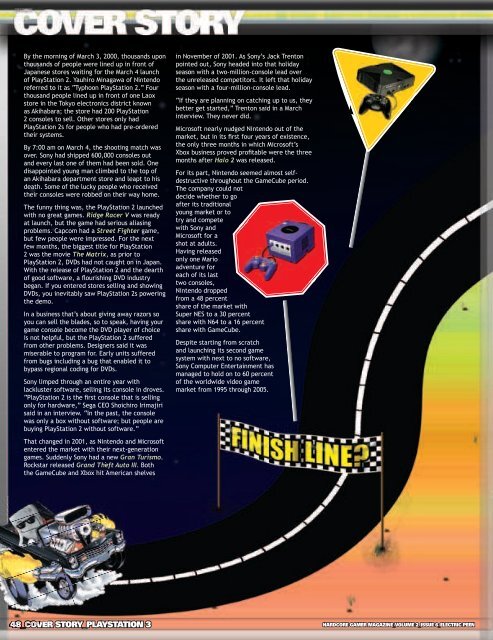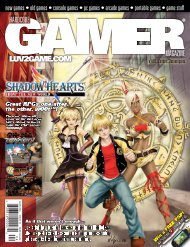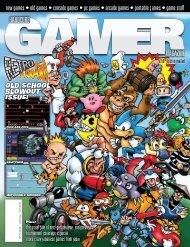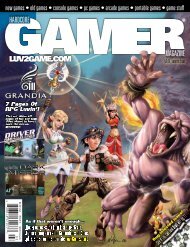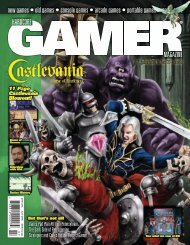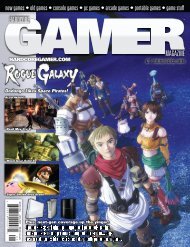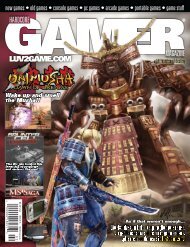Volume 2 Issue 6 December 2006 Sony ... - Hardcore Gamer
Volume 2 Issue 6 December 2006 Sony ... - Hardcore Gamer
Volume 2 Issue 6 December 2006 Sony ... - Hardcore Gamer
Create successful ePaper yourself
Turn your PDF publications into a flip-book with our unique Google optimized e-Paper software.
By the morning of March 3, 2000, thousands upon<br />
thousands of people were lined up in front of<br />
Japanese stores waiting for the March 4 launch<br />
of PlayStation 2. Yauhiro Minagawa of Nintendo<br />
referred to it as “Typhoon PlayStation 2.” Four<br />
thousand people lined up in front of one Laox<br />
store in the Tokyo electronics district known<br />
as Akihabara; the store had 200 PlayStation<br />
2 consoles to sell. Other stores only had<br />
PlayStation 2s for people who had pre-ordered<br />
their systems.<br />
By 7:00 am on March 4, the shooting match was<br />
over. <strong>Sony</strong> had shipped 600,000 consoles out<br />
and every last one of them had been sold. One<br />
disappointed young man climbed to the top of<br />
an Akihabara department store and leapt to his<br />
death. Some of the lucky people who received<br />
their consoles were robbed on their way home.<br />
The funny thing was, the PlayStation 2 launched<br />
with no great games. Ridge Racer V was ready<br />
at launch, but the game had serious aliasing<br />
problems. Capcom had a Street Fighter game,<br />
but few people were impressed. For the next<br />
few months, the biggest title for PlayStation<br />
2 was the movie The Matrix, as prior to<br />
PlayStation 2, DVDs had not caught on in Japan.<br />
With the release of PlayStation 2 and the dearth<br />
of good software, a ourishing DVD industry<br />
began. If you entered stores selling and showing<br />
DVDs, you inevitably saw PlayStation 2s powering<br />
the demo.<br />
In a business that’s about giving away razors so<br />
you can sell the blades, so to speak, having your<br />
game console become the DVD player of choice<br />
is not helpful, but the PlayStation 2 suffered<br />
from other problems. Designers said it was<br />
miserable to program for. Early units suffered<br />
from bugs including a bug that enabled it to<br />
bypass regional coding for DVDs.<br />
<strong>Sony</strong> limped through an entire year with<br />
lackluster software, selling its console in droves.<br />
“PlayStation 2 is the rst console that is selling<br />
only for hardware,” Sega CEO Shoichiro Irimajiri<br />
said in an interview. “In the past, the console<br />
was only a box without software; but people are<br />
buying PlayStation 2 without software.”<br />
That changed in 2001, as Nintendo and Microsoft<br />
entered the market with their next-generation<br />
games. Suddenly <strong>Sony</strong> had a new Gran Turismo.<br />
Rockstar released Grand Theft Auto III. Both<br />
the GameCube and Xbox hit American shelves<br />
in November of 2001. As <strong>Sony</strong>’s Jack Trenton<br />
pointed out, <strong>Sony</strong> headed into that holiday<br />
season with a two-million-console lead over<br />
the unreleased competitors. It left that holiday<br />
season with a four-million-console lead.<br />
“If they are planning on catching up to us, they<br />
better get started,” Trenton said in a March<br />
interview. They never did.<br />
Microsoft nearly nudged Nintendo out of the<br />
market, but in its rst four years of existence,<br />
the only three months in which Microsoft’s<br />
Xbox business proved protable were the three<br />
months after Halo 2 was released.<br />
For its part, Nintendo seemed almost selfdestructive<br />
throughout the GameCube period.<br />
The company could not<br />
decide whether to go<br />
after its traditional<br />
young market or to<br />
try and compete<br />
with <strong>Sony</strong> and<br />
Microsoft for a<br />
shot at adults.<br />
Having released<br />
only one Mario<br />
adventure for<br />
each of its last<br />
two consoles,<br />
Nintendo dropped<br />
from a 48 percent<br />
share of the market with<br />
Super NES to a 30 percent<br />
share with N64 to a 16 percent<br />
share with GameCube.<br />
Despite starting from scratch<br />
and launching its second game<br />
system with next to no software,<br />
<strong>Sony</strong> Computer Entertainment has<br />
managed to hold on to 60 percent<br />
of the worldwide video game<br />
market from 1995 through 2005.<br />
Finally, the launch of the PlayStation 3 is upon us, and the not-solittle<br />
black box is causing quite a stir. If you’re one of the lucky (and<br />
somewhat wealthy) people who’ll read this with a PlayStation 3 near at<br />
hand, then there is a lot that you should already know about the latest<br />
entry into the next-gen console war. If you’ve been sitting on the fence<br />
trying to decide if the system is worth all the hype, then you’ve still<br />
got plenty of decisions to make. Is the PS3 all that it is cracked up to<br />
be? Is it the denitive next-gen experience that <strong>Sony</strong> claims it to be? Is<br />
it worth the price of admission?<br />
The following write-ups are designed to help you answer those<br />
questions for yourself while giving new PS3 owners an opportunity to<br />
fully understand what they’re in for. The PlayStation 3 is a big deal; in<br />
fact, it’s a huge deal. Let’s break it up a bit and dive straight into the<br />
next generation of PlayStation from <strong>Sony</strong>.<br />
Make no mistake; the PlayStation 3 is one impressive piece of<br />
hardware. Powered by the CELL Processor and featuring Blu-Ray disc<br />
technology, <strong>Sony</strong> is truly attempting to make the PlayStation 3 a<br />
universal media device for the home. The question is exactly what<br />
this means for us hardcore gamers in the long run and how these new<br />
technologies actually impact what we care about most... the games!<br />
I know, I know, you’re all jacked up to have your PS3, and we will<br />
certainly discuss all the awesome things that you have in store in the<br />
immediate future, but before we do, let’s really examine what this<br />
console means to the industry. After all, if you just plunked down<br />
anywhere from $600 to over $1,000 for the console, some games, and<br />
accessories, you really should know about the ner points of your<br />
investment. You’re certainly going to have to justify the purchase to<br />
someone, aren’t you?<br />
Honestly, it’s kind of funny to think what consoles have become<br />
over the years. It’s evident that the gaming experience isn’t the<br />
sole purpose of gaming consoles anymore. Ever since the original<br />
PlayStation broke down the barriers that kept casual gamers away<br />
from the industry, companies like <strong>Sony</strong>, Microsoft and Nintendo<br />
have been striving to capture the mainstream audience<br />
while continuing to please those of us that have been at<br />
this gaming thing for the past twenty years or so.<br />
Despite who the target audience is, both as a gaming<br />
console and as a media device, the PlayStation<br />
3 contains more than enough tech to provide<br />
a complete experience. In fact, once you<br />
get your console home and plug it in, you’ll<br />
probably be tinkering with all the options and<br />
customization that will truly make it feel like a<br />
central part of your entertainment hub.<br />
Beyond launch, however, <strong>Sony</strong> has big plans for the<br />
PlayStation 3. In fact, they have big plans for the gaming<br />
industry. That’s something that was made evident at their<br />
(somewhat boring, but ultimately informative) press conference<br />
during the <strong>2006</strong> Tokyo Game Show.<br />
48_COVER STORY_PLAYSTATION 3<br />
HARDCORE GAMER MAGAZINE_VOLUME 2_ISSUE 6_ELECTRIC PEEN<br />
HARDCORE GAMER MAGAZINE_VOLUME 2_ISSUE 6_ELECTRIC PEEN<br />
PLAYSTATION 3_COVER STORY_49


